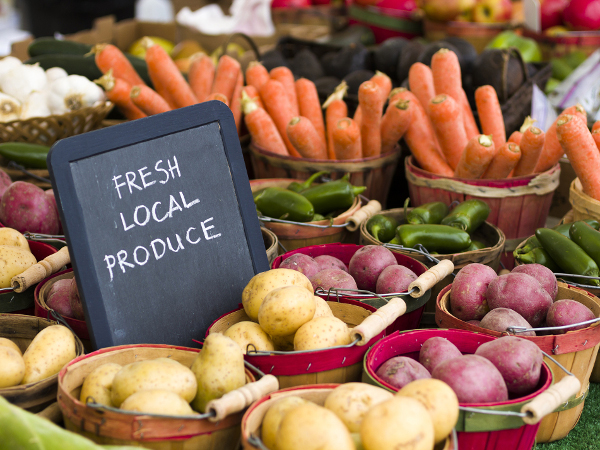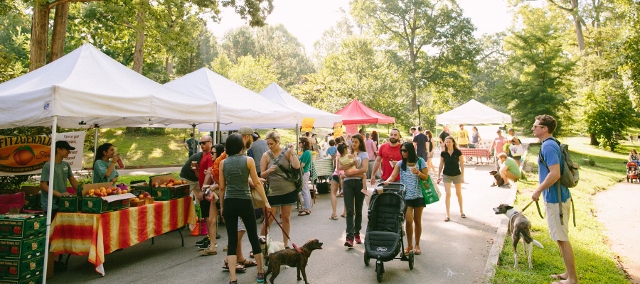Running a successful farmer’s market stall requires care and planning. Smallholders want to take advantage of the trend towards markets.
Farmer’s markets are becoming more and more popular because people want to support local farmers and artisans. They feel that eating fresh, healthy food is important and they want to reduce the carbon footprint of their consumerism. They also enjoy the community atmosphere of the market.
So you might feel that such a market is the best way of selling your produce, but how do you make a success of your stall?
Eye-catching Display
You need to create an attractive and colourful display to grab the attention of the customers. Stand in front of your stand to check how oncoming potential customers see you. Choose a name that tells people what you are promoting and have an eye-catching and clearly visible sign or banner, so that they can see immediately what you are offering.
Pretty table-cloths should reach the ground in front of your table or counter, so that you can store goods underneath them.
Add a dash of whimsy to your display, with unique items, such as chalkboard signs or a rustic piece of art. If electricity is available, a string of lights creates a fun, party-like feel.
Display the best examples of your produce and lay them out tidily and in such a way that they are easy to pick up. Less than perfect produce can be processed, e.g. use it to make jams or chutneys, which you can also sell.

Think about your appearance – crisp overalls or colourful aprons look smart and professional. In warmer weather you can wear a t-shirt that has the name of your stand printed or embroidered on it. Temperature will vary throughout the market day, so start with layers you can easily take off as things warm up.
Be sure to wear comfortable shoes, because you need to be standing at your stall at all times. Smile and be welcoming. You need to be approachable and certainly not sitting looking at your phone.
Look After Yourself
Remember to eat a solid meal before market, and drink plenty of water throughout the day. Make a plan about how and when you are going to eat if you are there for the whole day. Get someone to relieve you for a while, so that you can go and have some lunch and go the toilet. Even though your stall might be all about food, it can be a turnoff for customers to watch a vendor eat.
Engage your customers in conversation. When customers feel as if they’ve made a personal connection with you, they’ll be much more likely to return again and again. However try not to talk to one customer for too long if others are waiting. Have a brochure or other reading matter that they can look at while they are waiting.
Find characteristics about your product that make it superior to that of other vendors, find your unique selling point (USP). Are your wares genuinely organic? Is your jam recipe different from the usual? Is your handmade soap made of finer ingredients? Are you catering for special dietary requirements, i.e. is your produce gluten-free or suitable for diabetics, etc?
Realistic Pricing
Don’t undervalue your products, but don’t charge unrealistically high process. Do your market research beforehand and find out what the going rate is for your type of produce. Make sure your pricing is clear. Decide whether it is cost-effective to print coloured labels.
Packaging can make the difference between perceived high-quality and average-quality. For instance, bars of homemade soap with a pretty wrapper, tied with raffia, look like they’ve had more care than bars of soap just piled in a bin. Pick colours and a design that play on the local aspect of your product.
Added Extras Make a Successful Market Stall
Providing printed cards with your favourite recipes encourages purchases, especially if you focus on recipes for some of your more unusual items that don’t sell as well.
Plan your harvest and product lines so you have a consistent supply of produce.
If it is possible, have samples of your produce for people to taste.
Think of a way to engage children at your stall.
Try to identify and remember your key weekly customers by name. Ask them how they used your products and if they were satisfied with them or if they have any suggestions to make.
Keep the weekly process of packing for market stress-free with a permanent checklist of everything you need, from change in the cash box to your business cards. It’s easiest to have one permanent bin with all your key supply essentials for the season.
You have to persevere – consider success at the farmer’s market an on-going journey of learning. Keep experimenting and trying different approaches and, whenever possible in your travels, visit other markets and bring new perspectives back home to your neighbourhood.
For other ideas on making an income from your small farm click here.
To subscribe to SA Smallholder Online click here.

